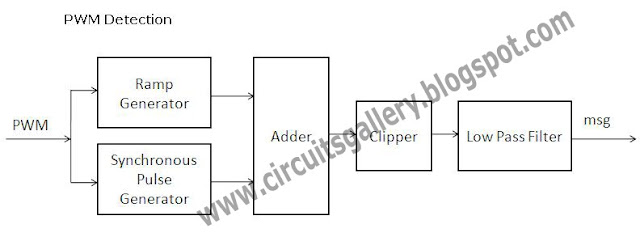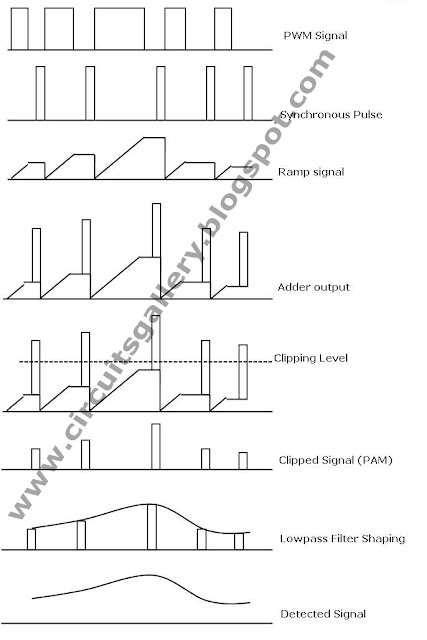How to detect or demodulate a Pulse Width Modulated Signal? PWM pulse can be detected using Ramp generator and some circuit combinations.
We have discussed PWM generator circuit using 741 op amp in previous articles. The coded message in the form of PWM can be easily decoded with the help of a synchronous pulse. The most simple demodulation principle of PWM signals are describes in this article
The block diagram itself explaining all the decoding principles. Waveforms at different sections of Pulse width demodulation are also given here.
PWM signals have wide verities of applications like PWM Inverter circuit, PWM LED brightness control or Dimmer circuit etc.
We have discussed PWM generator circuit using 741 op amp in previous articles. The coded message in the form of PWM can be easily decoded with the help of a synchronous pulse. The most simple demodulation principle of PWM signals are describes in this article
The block diagram itself explaining all the decoding principles. Waveforms at different sections of Pulse width demodulation are also given here.
PWM signals have wide verities of applications like PWM Inverter circuit, PWM LED brightness control or Dimmer circuit etc.
PWM Demodulator Block Diagram
(Fig : 1)
- PWM coding can be done using 741 op amp that we discussed before. Here the modulated (PWM) wave is applied to the decoder system for getting the message signal.
- The basic theory behind Pulse width demodulation is that converting the PWM signal to PAM (Pulse Amplitude Modulation) signal. PAM can be easily detected by suitable low pass filter.
- Input PWM wave is applied to Ramp generator and Synchronous Pulse generator (Fig : 1).
- Synchronous pulse generator will generate a pulse waveform such that the pulse will end at the beginning of each PWM pulse (See the fig below)
- Ramp generator will produce a ramp signal whose amplitude is proportional to width of the PWM signal (See the fig below)
- Now apply these Ramp and Synchronous pulse to an Adder circuit which adds these signals together.
- The next block is a positive Clipper with a specific voltage; Clipper clips the waveform at a particular level as shown in fig.
- The output of clipper will be PAM signal, now the PWM signal gets converted to PAM signal.
- The PAM can be demodulated by Low Pass filtering method. Thus our next block is Low Pass Filter.
- Ramp Generator + Synchronous Pulse + Adder + Clipper = PWM to PAM Converter
(Click on the image for enlarged view)
Each and every steps of PWM demodulation wave forms are shown in above chart.
Keep visiting CircuitGallery for more circuits...
Ads






+Circuit+diagram+using+CD4047+and+IRFZ44+power+MOSFET.png)





0 comments:
Post a Comment